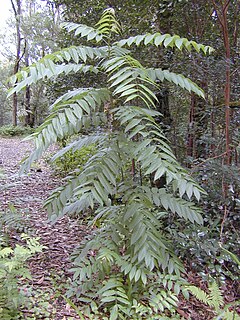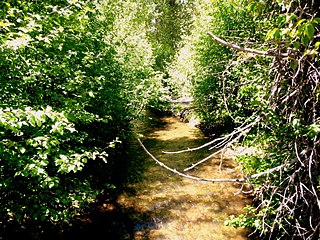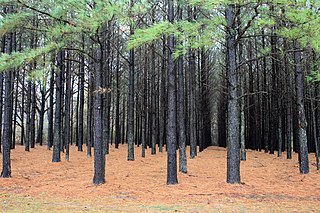Related Research Articles

Forestry is the science and craft of creating, managing, planting, using, conserving and repairing forests, woodlands, and associated resources for human and environmental benefits. Forestry is practiced in plantations and natural stands. The science of forestry has elements that belong to the biological, physical, social, political and managerial sciences. Forest management play essential role of creation and modification of habitats and affect ecosystem services provisioning.

Coppicing is a traditional method of woodland management which exploits the capacity of many species of trees to put out new shoots from their stump or roots if cut down. In a coppiced wood, which is called a copse, young tree stems are repeatedly cut down to near ground level, resulting in a stool. New growth emerges, and after a number of years, the coppiced tree is harvested, and the cycle begins anew. Pollarding is a similar process carried out at a higher level on the tree in order to prevent grazing animals from eating new shoots. Daisugi, is a similar Japanese technique.

Thinning is a term used in agricultural sciences to mean the removal of some plants, or parts of plants, to make room for the growth of others. Selective removal of parts of a plant such as branches, buds, or roots is typically known as pruning.

A harvester is a type of heavy forestry vehicle employed in cut-to-length logging operations for felling, delimbing and bucking trees. A forest harvester is typically employed together with a forwarder that hauls the logs to a roadside landing.
Silviculture is the practice of controlling the growth, composition/structure, and quality of forests to meet values and needs, specifically timber production.

An old-growth forest – also termed primary forest, virgin forest, late seral forest, primeval forest or first-growth forest – is a forest that has attained great age without significant disturbance and thereby exhibits unique ecological features and might be classified as a climax community. The Food and Agriculture Organization of the United Nations defines primary forests as naturally regenerated forests of native tree species where there are no clearly visible indications of human activity and the ecological processes are not significantly disturbed. More than one-third of the world’s forests are primary forests. Old-growth features include diverse tree-related structures that provide diverse wildlife habitat that increases the biodiversity of the forested ecosystem. Virgin forests are old-growth forests that have never been logged. The concept of diverse tree structure includes multi-layered canopies and canopy gaps, greatly varying tree heights and diameters, and diverse tree species and classes and sizes of woody debris.

In the United Kingdom, an ancient woodland is a woodland that has existed continuously since 1600 or before in England, Wales and Northern Ireland. Planting of woodland was uncommon before those dates, so a wood present in 1600 is likely to have developed naturally.

Clearcutting, clearfelling or clearcut logging is a forestry/logging practice in which most or all trees in an area are uniformly cut down. Along with shelterwood and seed tree harvests, it is used by foresters to create certain types of forest ecosystems and to promote select species that require an abundance of sunlight or grow in large, even-age stands. Logging companies and forest-worker unions in some countries support the practice for scientific, safety and economic reasons, while detractors consider it a form of deforestation that destroys natural habitats and contributes to climate change.
This article is the index of forestry topics.

Toona ciliata is a forest tree in the mahogany family which grows throughout southern Asia from Afghanistan to Papua New Guinea and Australia.

Biomass is plant-based material used as fuel to produce heat or electricity. Examples are wood and wood residues, energy crops, agricultural residues, and waste from industry, farms and households. Since biomass can be used as a fuel directly, some people use the words biomass and biofuel interchangeably. Others subsume one term under the other. Government authorities in the US and the EU define biofuel as a liquid or gaseous fuel, used for transportation. The European Union's Joint Research Centre use the concept solid biofuel and define it as raw or processed organic matter of biological origin used for energy, for instance firewood, wood chips and wood pellets.
The following outline is provided as an overview of and guide to forestry:
In forestry, the optimal rotation age is the growth period required to derive maximum value from a stand of timber. The calculation of this period is specific to each stand and to the economic and sustainability goals of the harvester.
Forest farming is the cultivation of high-value specialty crops under a forest canopy that is intentionally modified or maintained to provide shade levels and habitat that favor growth and enhance production levels. Forest farming encompasses a range of cultivated systems from introducing plants into the understory of a timber stand to modifying forest stands to enhance the marketability and sustainable production of existing plants.

A forest product is any material derived from forestry for direct consumption or commercial use, such as lumber, paper, or fodder for livestock. Wood, by far the dominant product of forests, is used for many purposes, such as wood fuel or the finished structural materials used for the construction of buildings, or as a raw material, in the form of wood pulp, that is used in the production of paper. All other non-wood products derived from forest resources, comprising a broad variety of other forest products, are collectively described as non-timber forest products (NTFP). Non-timber forest products are viewed to have fewer negative effects on forest ecosystem when providing income sources for local community.
Variable retention is a relatively new silvicultural system that retains forest structural elements for at least one rotation in order to preserve environmental values associated with structurally complex forests.

Sun Pass State Forest is one of six state forests managed by the Oregon Department of Forestry. The forest is located 40 miles (64 km) north of Klamath Falls, Oregon near the southeastern corner of Crater Lake National Park. It is the largest single block of Oregon state forestry land east of the Cascade Mountains. The forest is managed as part of the Klamath-Lake District, comprising 21,317 acres (86.27 km2) of the 33,739 state-owned acres within the district.

Santiam State Forest is one of six state forests managed by the Oregon Department of Forestry. The forest is located approximately 25 miles (40 km) southeast of Salem, Oregon, and includes 47,871 acres (193.73 km2) on the western slope of the Cascade Mountains in three Oregon counties: Clackamas, Linn, and Marion. It is bounded on the east by the Willamette National Forest and Mount Hood National Forest. Silver Falls State Park is located west of the forest. The rest of the land surrounding the forest belongs to the Bureau of Land Management or is privately owned. The forest is managed as part of the Department of Forestry's North Cascade District.

The deforestation in British Columbia has occurred at a heavy rate during periods of the past, but with new sustainable efforts and programs the rate of deforestation is decreasing in the province. In British Columbia, forests cover over 55 million hectares, which is 57.9% of British Columbia's 95 million hectares of land. The forests are mainly composed of coniferous trees, such as pines, spruces and firs.

A tree plantation, forest plantation, plantation forest or timber plantation is a forest planted for high volume production of wood, usually by planting one type of tree as a monoculture forest.
References
- ↑ "Subsection Forest Planning Glossary". Minnesota Department of Natural Resources. 2008. Retrieved 2009-04-22.
- ↑ Roberge, Jean-Michel; et al. (2016). "Socio-ecological implications of modifying rotation lengths in forestry". Ambio. 45, Suppl. 2: S109–S123. doi:10.1007/s13280-015-0747-4. PMC 4705071 . PMID 26744047.